If you are curious how many different types of cherries are on earth, then the answer might surprise you. In reality, there are more than 1,000 cherry varieties worldwide with different traits. However, not all of these variations are edible.
And in this article, I will discuss in detail edible cherries that you can enjoy fresh or turn into tasty dishes and drinks. Of the cherry types I’m about to show you, some might be familiar to you, while others might not.
So why don’t you spend some minutes exploring some of the best cherries in the world? I guarantee you can learn something new today!
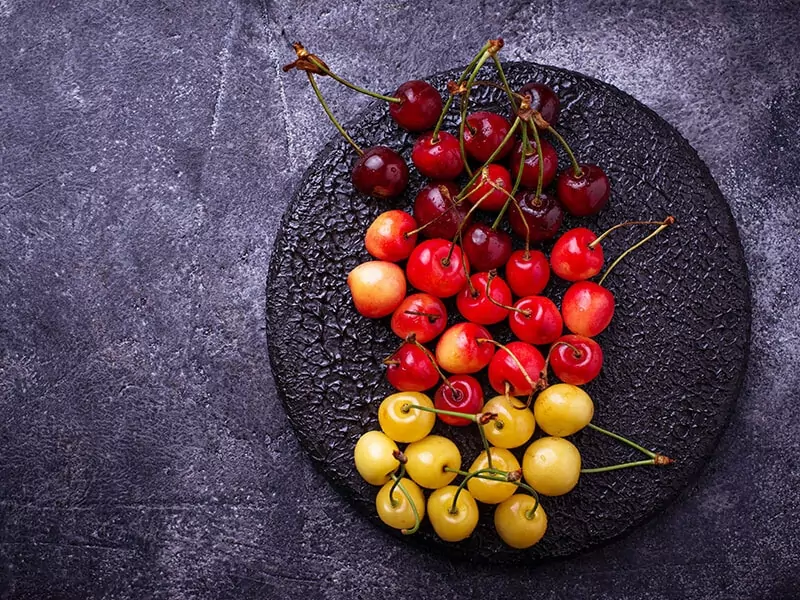
The Overall View About Cherry
A bowl full of fresh and juicy cherries is truly a big hit in summer, right? But their seasons normally are short, so it is important to know the right tricks to freeze fresh cherries. And similar to other fruits, the cherry has many interesting facts that you might not know before.
Cherry is a type of stone fruit that includes a large hard seed in the center covered by its fleshy pulp. It might take 3 to 5 years for a cherry tree to produce fruit, but a mature tree can provide 20 to 60 quarts of cherry fruits annually.
Moreover, cherry trees need a certain time in cold weather to bloom and produce fruit. That’s why they are popular in cold-climate countries or areas. But some varieties can develop in tropical climates too!
Most types of cherries can be divided into 2 big groups: Sweet cherries (Prunus avium) and Sour (or Tart) cherries (Prunus cerasus). There is also a minor category of edible cherries that doesn’t fall under the two. All of them are different from each other. Let’s have a closer look!
20 Types of Sweet Cherry To Beat The Hot Summer
Sweet cherry (Prunus avium) contains various smaller varieties worldwide with specific characteristics. They are the best types for consuming fresh, even right after picking them from the tree.
This section has 20 sweet cherry varieties from many places in the world, so I divide them into 3 minor groups based on their geographical origin. If you want to check them quickly, the below chart will show you brief information about these 20 tasty cherries.
7 Stunning American-Based Sweet Cherry Cultivars
Let’s talk about American sweet cherry varieties first. With these 7 types and their stories, I hope you can have a close view of them in order to find which types would be your favorite one.
1. Bing
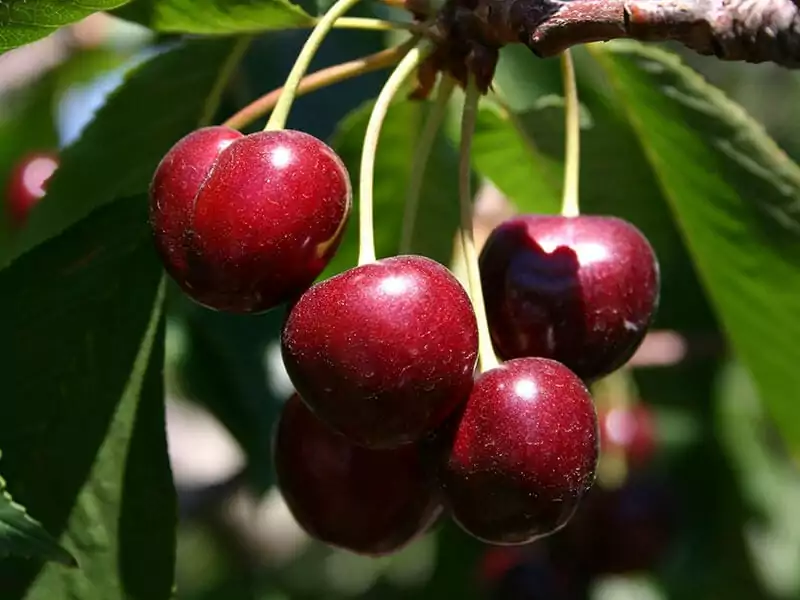
When talking about glossy and juicy cherries with a distinctive heart shape, Bing cherry is the first one that comes to my mind. Thanks to their sweet, tangy, and firm flesh, this type is perfect for snacks or as an addition to your simple grilled desserts, ice cream, and more.
Native to the Pacific Northwest, particularly in Oregon, America, Bing is one of the most well-known cherry types in the USA. They are also the most widely cultivated type across the country, including California, Washington, Oregon, Wisconsin, and British Columbia in Canada.
They are a hybrid cherry of Royal Ann cherry (aka Napoleon) and Black Republican cherry. And this was an invention of Ah Bing (a foreman) and Seth Lewelling (a horticulturist) in 1875.
Bing cherries generally have a deep red color. Plus, the darker they are, the riper they will be. This type of cherry is very rich in antioxidants that benefit gout and arthritis patients.
Origin: Milwaukie, Oregon, the United States (1875)
Season: Depending on regions, might range from May to late July
Check here for choosing the freshest Bing cherries.
2. Rainier
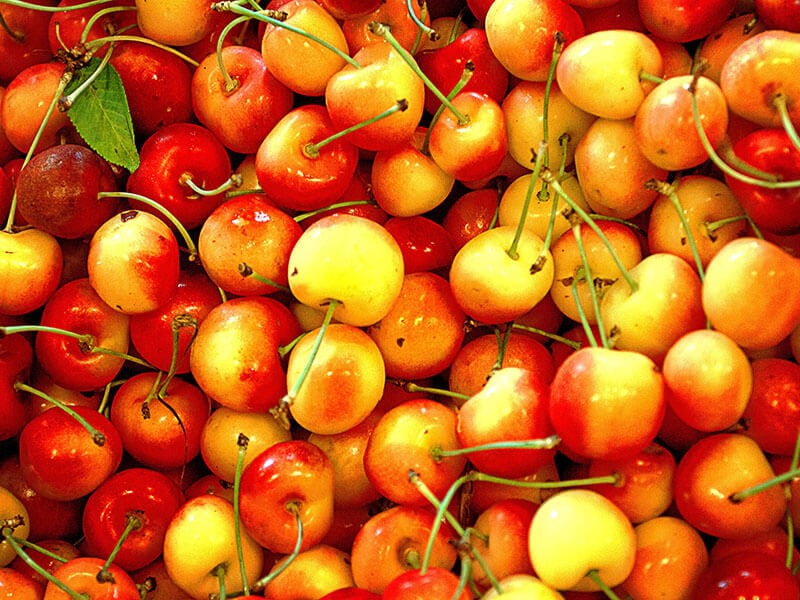
Rainier is another tasty fruit that you can enjoy raw or various desserts with cherry. And they are easier to recognize at the markets due to their creamy yellowish-red flesh color. However, their season is pretty short (from late June to early July), making them a premium cherry at high prices.
Another reason that makes them a pricey cherry is Rainier cherries are sensitive to outer impacts like rain, temperature, and wind. Moreover, their fleshes tend to be juicier than other sweet cherries.
Rainier is a cross between 2 cherry cultivars: Bing and Van cherries. In 1952, Harold Fogle in Washington State University introduced this cherry variety to the public. Americans love it so much that they even celebrate National Rainier Cherry Day annually on 11th July, especially in Washington.
Origin: Washington State University (1952)
Season: Harvested from late June to early July
What is the story behind these succulent Rainier cherries? Let’s watch this documentary.
3. Lambert
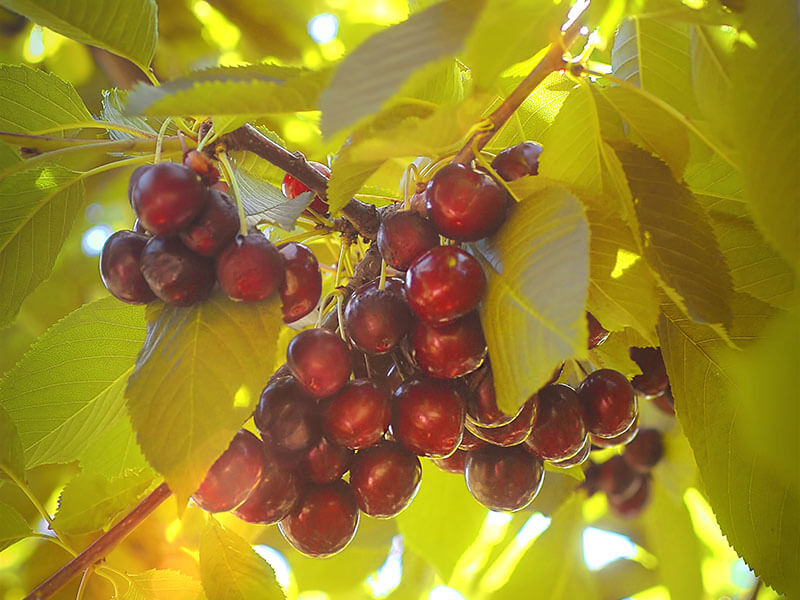
Lamber cherry is named after Joseph Hamilton Lambert – an American orchardist and pioneer who cultivated this type in 1848. These cherries have an attractive heart-shaped appearance in bright-to-dark red color and a sweet, rich flavor.
This variety also comes in a larger shape with a relatively small pit. On the other hand, the crispiness and juiciness of Lambert cherries are ideal to consume right off the trees. They can retain their texture after cooking, so feel free to use them in making baked goods.
For more information, in 1916, Lambert cherries were claimed as the “finest” cherry in the USA. Today, you can easily find this type in the Pacific Northwest, North America, especially in Oregon.
Origin: Oregon (1848)
Season: Start to ripen in early or mid-July
4. Chelan
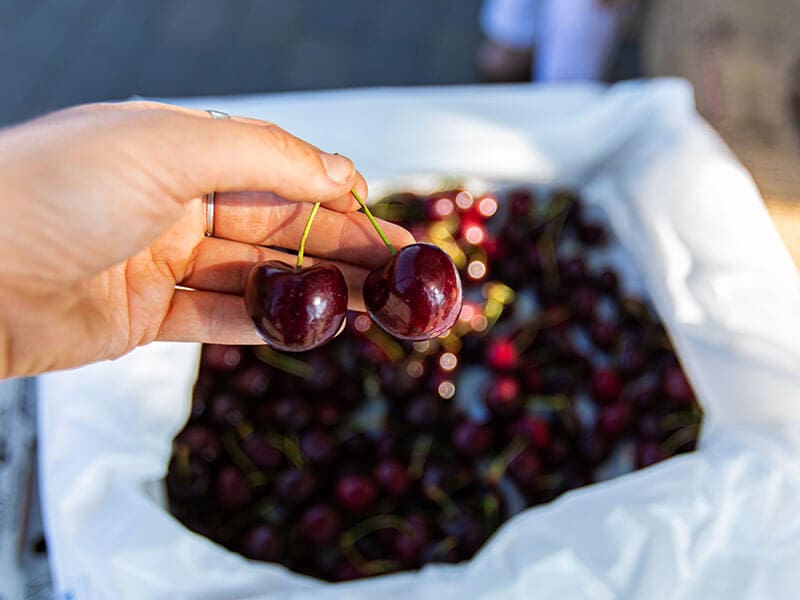
Another excellent candidate in anti-cracking is Chelan cherry. Originated in Process city in Washington, this excellent fruit starting with the letter C is an early-season type that can produce medium, firm-yet-juicy fruits with a mildly sweet flavor that contains around 18% sugar.
Like Bing cherries, this type carries a heart-shaped, deep mahogany red look that can turn into almost black, resulting in another name – black cherry. However, they are ready to pick around 2 weeks sooner than Bing cherries.
Actually, this variety was crossed between Beaulieu and Stella cultivars by Thomas Toyama and Ed Proebsting (University of Washington) in 1971. Chelan cherry is the first sweet cherry variety developed in America’s Pacific Northwest. You can also find it in Australia and Canada, too.
Origin: Prosser city, Washington (1971)
Season: Early-season (late May in California or mid-late June in Washington)
5. Tieton
Tieton cherry is a crossbreed of Early Burlat and Stella cherry, and this cultivar was a result of Washington State University. They are an early-season cherry that can yield dark red sweet fruits. However, this variety might not produce high yields like other types.
These cherries are similar to Bing species with cute heart-like shapes and extra-large in size (some can reach 32-mm in width). They also own glossy mahogany-red skins that make them so appealing from a first look.
Tieton’s flavor is fairly mild and firm in texture, making them an ideal option for baked goods. Besides, their trees have thick stems to help the fruits retain moisture and have a fresher look after harvesting. However, they are prone to cracking, mildew, or double fruits.
Origin: Washington State, USA
Season: Early-season
6. Utah Giant
Originated in Lagan, Utah, Utah Giant cherry is a cultivar of Utah Agricultural Experiment State in 1981. Unlike its name, this cherry type comes from small to moderate-sized trees. But their fruits are surprisingly large (even bigger than Bing or Lamber ones) with outstanding flavor.
Thanks to their compact sizes, they can be a great choice for gardeners. However, this is not a self-pollinating cherry type, so they need other types of sweet cherries nearby as pollination partners. Suitable ones can be Bing, Rainier, Van, and more.
When Utah Giant cherries are fully mature, they will have a dark red mahogany color in skin and flesh. Their flavor is also sweet, but the best thing must be how the flesh doesn’t stick to the pit. (because Utah Giant is a freestone variety). Its pit is smaller than other types as well.
Origin: Logan, Utah (1981)
Season: Ripen in May to early June and can harvest on mid-season
7. Tulare
Tulare is a cousin of Bing cherry with many of the same characteristics. First, they have a perfectly sweet, tangy, tart flavor with a juicy texture. However, this type is quite softer than Bing but still firm enough to enjoy fresh or baking sweet or savory dishes.
Tulare cherry’s first appearance was recorded in San Joaquin Valley in the southern part of California in 1974. After that, in 1988, Bradford Genetic perfected this cultivar for commercial production, making them more popular in Southern California.
Those cherries were named after Tulare County, where people found them. Tulare cherries are crack-resistant and have a smooth heart-shaped appearance with stunning deep red color. But they require at least 1 sweet cherry tree as a pollinating agent nearby to yield fruits.
Origin: Southern California (1988)
Season: Ready to collect in late spring to early summer
Here is a short video capturing a Tulare cherry farm that started to blossom.
Some Popular Sweet Cherry Types Originated From Canada
North of the United States is Canada, a country with many heavenly-send cherry species with various distinguished characteristics. Read on to find out what they are!
8. Van
A special cherry species in Canada is the Van cherry. It produces medium-sized sweet and firm fruits that you can serve as a healthy snack or make juices, jam, etc.
Hailing from Summerland Research Station in British Columbia, Canada, this cherry cultivar is the combination of Empress Eugenie and other types. It isn’t self-pollinating, so pollinators are needed. This species can work well with other varieties like Stella, Bing, Montmorency, and more.
Their trees are pretty hard, so they can bear many fruits. The fruits have round or heart-like shapes with dark red color.
Origin: In Summerland, British Columbia and was introduced in 1944)
Season: Start to fruiting from mid-season (around mid-June)
9. Lapins
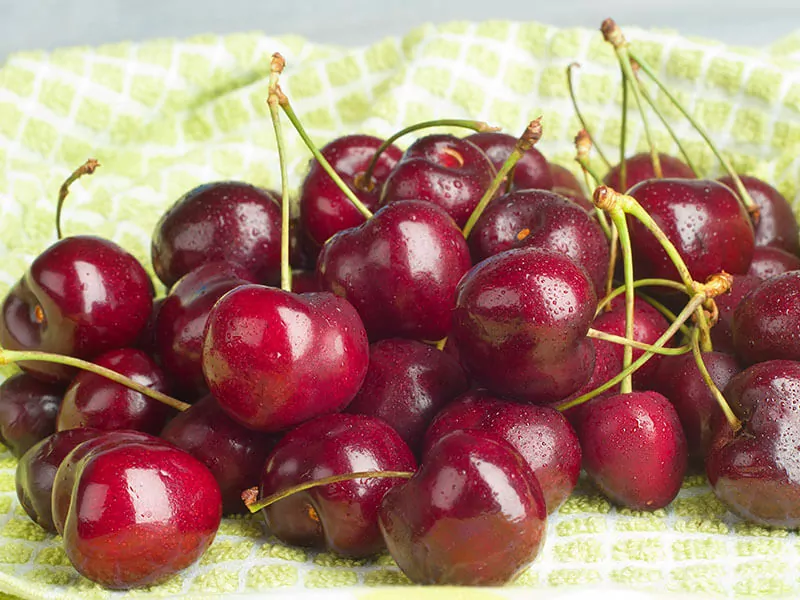
Born in the same place as Van cherry, Lapin is another special cultivar of Summerland Research Station, particularly by Karlis O. Lapins – a Canadian agronomist. In general, they are an upgraded version of the Bing type with higher qualities.
An advantage of this species is that they are still sweet before turning to deep-red fruits. The versatility of Lapins is amazing as you can eat them raw, make hearty BBQ desserts, juice, preserves, and more.
Lapins cherry is a hybrid version of Van and Stella cherries. It is a self-fertile type that can be an ideal pollinator for other cherry species. So if you want grow various kinds of cherry trees, the Lapins cherry is a good choice.
The tree can grow to 4-meter tall with high yields. Lapins cherries’ flesh is firmer and can resist splitting excellently compared to Bing. Regarding the visual, they share a similar look as Bing cherries with dark red color when fully matured.
Origin: Summerland (British Columbia)
Season: Late-summer season (late June to August)
What does it look like in Lapin cherry season?
10. Sweetheart
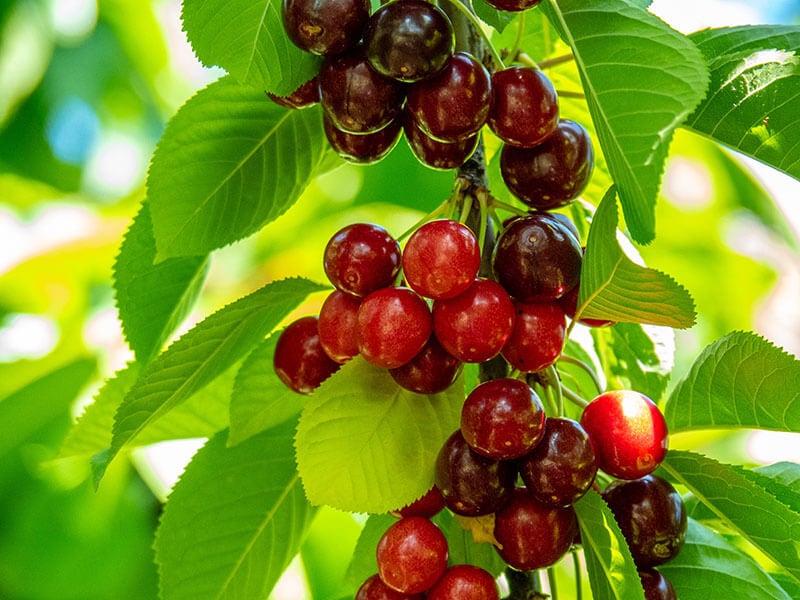
As the name suggests, Sweetheart cherries are hard to resist due to their wonderful sweetness in a dark vibrant red skin and red flesh. They also have a slight hint of acidic taste to create a balanced sweet and sour flavor.
Like other types, the Sweetheart variety has a heart-shaped appearance and moderate size. It is the combined result of Van and Newstar cherries. The Pacific Agri-Food Research Centre in Canada released it to the public in 1994.
This is a self-fertile type, making them a universal pollinator for various cherry cultivars. But they are a late-season cherry species that can ripen around 20 to 22 days later than Bing cultivar.
Origin: Summerland, British Columbia, Canada
Season: Late-ripening (ready to eat around August)
11. Stella
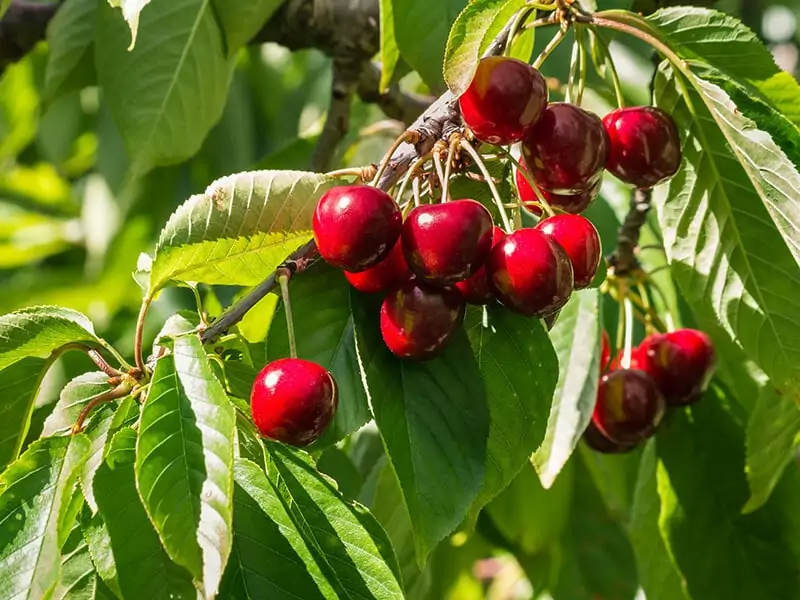
Stella is the first self-pollinating sweet cherry cultivar to be created. People have used it to develop other types, like Chelan, Tieton, Lapins, etc.
This cultivar was a result of the joint program between England and Canada to develop a high-quality self-fertile cultivar. Finally, agronomist and university professor Karlis O. Lapins succeeded in crossing between Lambert and John Innes Seedling 2420 to create it.
Generally, Stella fruits are large (bigger than average cherry), bold dark red, and heart-shaped. They are also rich in flavor, sweet, and superbly firm, making them a great choice for fresh snacks or baking.
Origin: Summerland (British Columbia)
Season: Can harvest from June to July
Some tips for growing a healthy Stella cherry tree are here!
12. Skeena
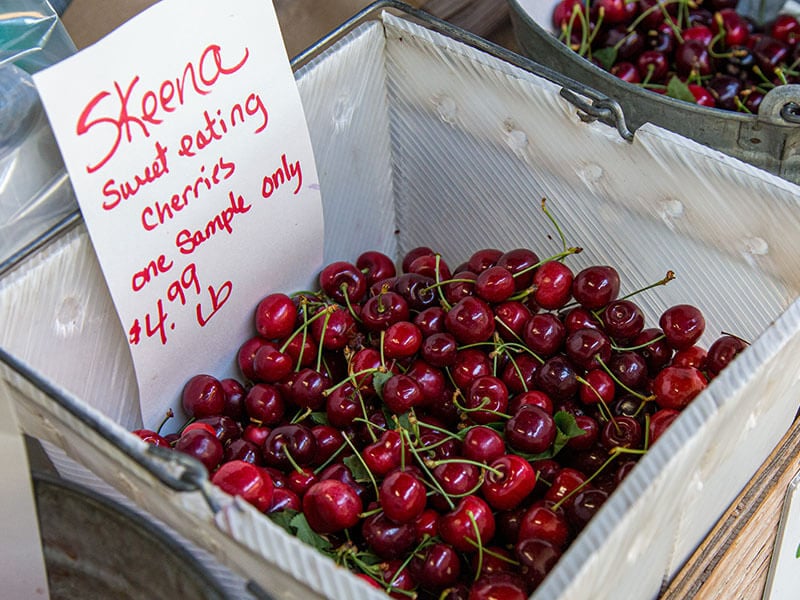
Another Canadian-based cherry is Skeena. They are a hybrid of 2 unnamed cultivars and were cultivated by Pacific Agri-Food Research Centre to create a high-quality cherry for late-ripening (14 to 16 days after Van cherry).
This self-fertile sweet cherry type can provide extremely firm fruits in large sizes. The attractiveness and tanginess of Skeena cherries are undeniable, thanks to their smooth skin ranging from dark red to black and juicy sweet flesh.
Their high cracking resistance capacity is another criterion for making them a superior-quality cherry. But they are prone to high temperatures, especially in the long period, which can lead to several post-harvest issues.
Origin: Made in 1973 in Summerland, British Columbia, and selected in 1984
Season: Late-season cherry (that can extend to early August)
13. Sylvia
Raised in Canada in 1957, Sylvia is a crossbreed of Sam and Van cherries to produce round, bright dark red fruits with red pulps. These fruits have a medium-sized, packed sweet flavor that makes them best suited for eating raw.
They are, basically, a dwarf self-fertile tree. Still, it would be better to yield higher-quality fruits if suitable pollination partners (like Kordia, Skeena, etc.) nearby the Sylvia cherry trees. The firmness of this cultivar is fairly good.
Today, you can find them grown in Canada, the United States, Australia, the United Kingdom, and more.
Origin: Summerland, Canada (made in 1957 and released in 1988)
Season: Mid-season fruit (around July)
14. Santina
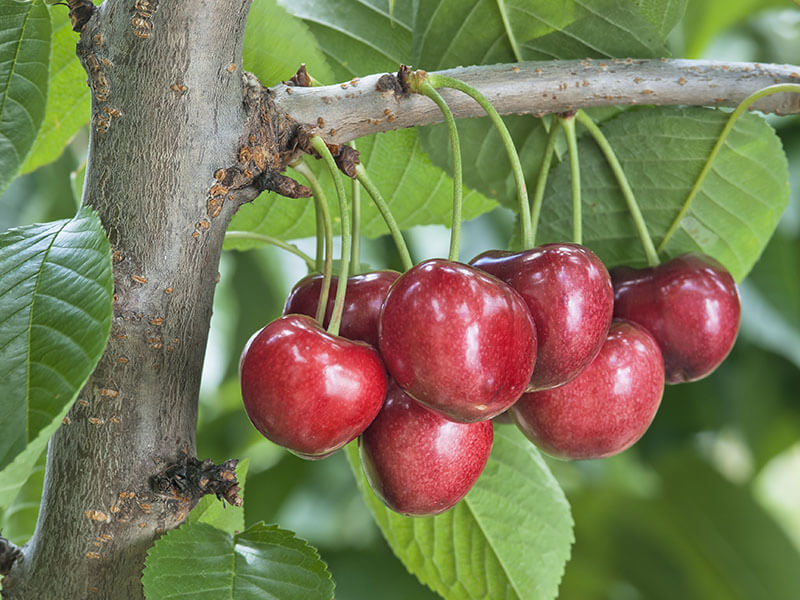
The last Canadian-origin cherry I want to introduce is Santina – a beautiful reddish-black fruit with a long and quite flat heart-shaped look. Not only visually stunning, but they are also ideal for eating fresh, thanks to their firm texture and mildly sweet taste.
Appearing in 1973, Santina is a self-pollinate species that crosses between Stella and Summit cherries. This was another result of the Pacific Agri-Food Research Station in Summerland. Today, it is a gardeners’ favorite cultivar due to their high production and good crack resistance.
Overall, they are medium-sized cherries with a sweet and low-acid profile. So if you do not want to enjoy them fresh, you can preserve them (such as freezing or drying) or pair these juicy fruits with your favorite treats.
Origin: Summerland, British Columbia, Canada (1973)
Season: Early-season
Other Sweet Cherry Species From Other Countries
Cherry is also well-loved in various countries, not just America and Canada. Here are 5 other cherry varieties in the sweet cherry species from other nations that you might not know yet.
15. Regina
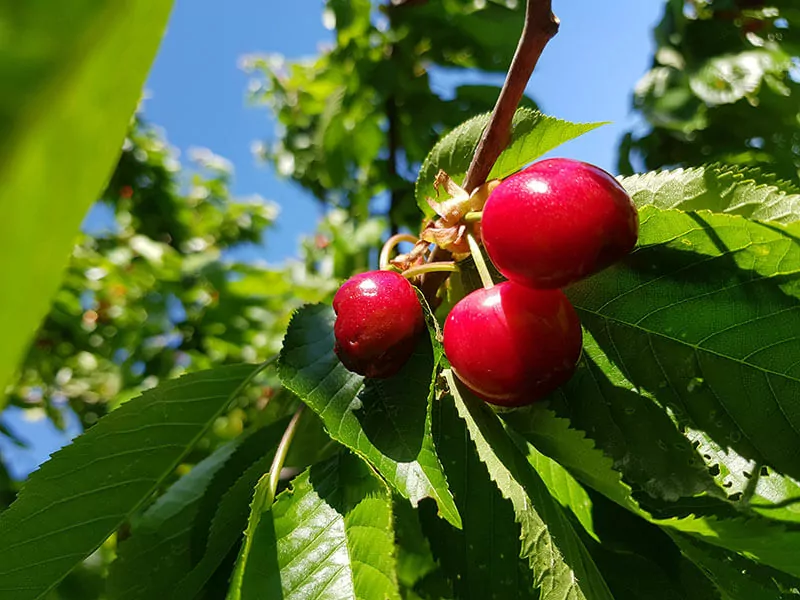
Regina is a German-origin cherry that the Jork Fruit Research Station developed in 1998. They are a crossbreed of Rube and Schneiders Spate Knorpelkirsche varieties. Nowadays, you can spot them in many European countries; some are also cultivated in Oregon, USA.
Overall, Regina can grow well in cold climates. They are a late-season cherry type that can produce large, dark red flesh and peel. Thanks to its sweet-and-tart taste, these fruits can offer you a strong hint of cherry essence in 1 bite.
These firm and succulent cherries are also good at resisting rain-cracking, making them the most successful sweet cherry type in Germany.
Origin: Germany (1998)
Season: Late June for harvesting
16. Queen Anne
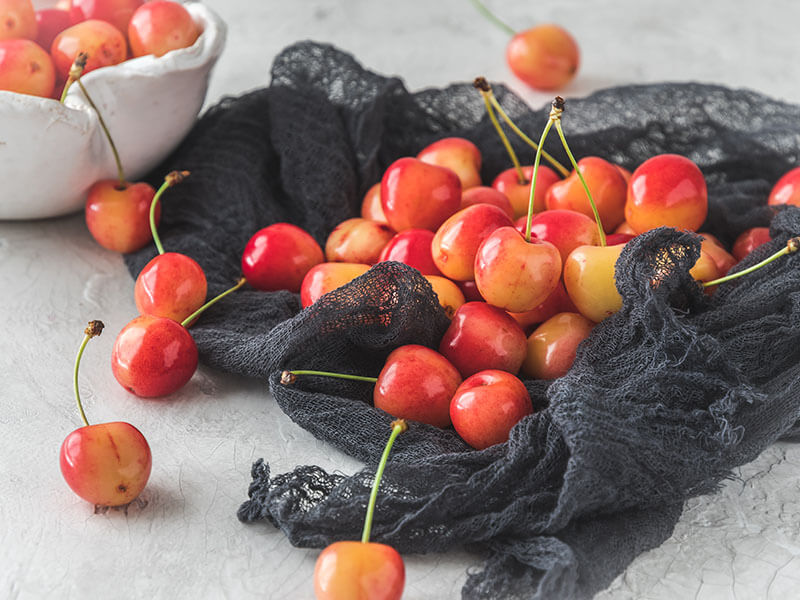
Queen Anne cherry – a fruit starting with Q, is a well-known type with a yellow and light-pink appearance similar to Rainier. They also have other names like Royal Ann or Napoleon. Their true origin is still unknown, but they were brought to America in 1629 by the colonists.
Though they are classified in sweet cherry species, their firm flesh tastes more tart than sweet, making them better for homemade ideas like jams, sauces, or baked goods. And if you love dishes made from canned cherries, you should know that this type appears in many canned products.
In reality, many people use it to make maraschino cherries, which I will explain in more detail in the next part. The only drawback of this species is their trees are fragile and sensitive, so it would not be too ideal for home orchards.
Origin: Believed as a Turkish-origin type and brought to the USA in 1629
Season: Mid-summer (for harvesting)
17. Emperor Francis
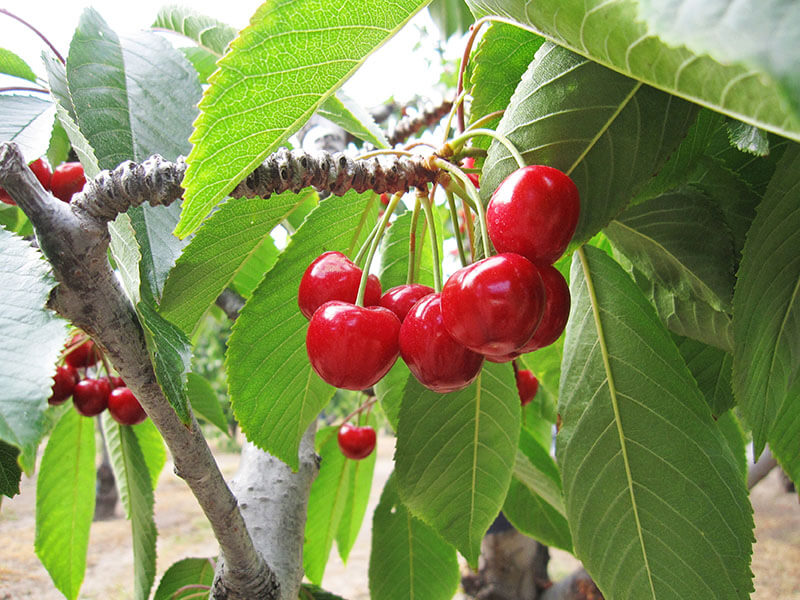
Here is another super sweet cherry type to add to your must-try fruit list. Emperor Francis cherries come in yellow (or white) flesh and skin with an extremely sweet taste. Their smooth and creamy texture is another reason why you should enjoy them fresh.
But it does not mean they are not ideal for jams, jellies, etc. They are also a multipurpose type that you can enjoy any way you want. They can even be a perfect type for Maraschino cherries.
They are also well-loved for their less susceptibility to cracking, turning them a favorite type for farmers and home gardeners. For more information, Emperor Francis is native to the United Kingdom and has been planted globally today.
Origin: The United Kingdom (the early 1990s)
Season: Ripen/harvest in late June
18. Coral Champagne
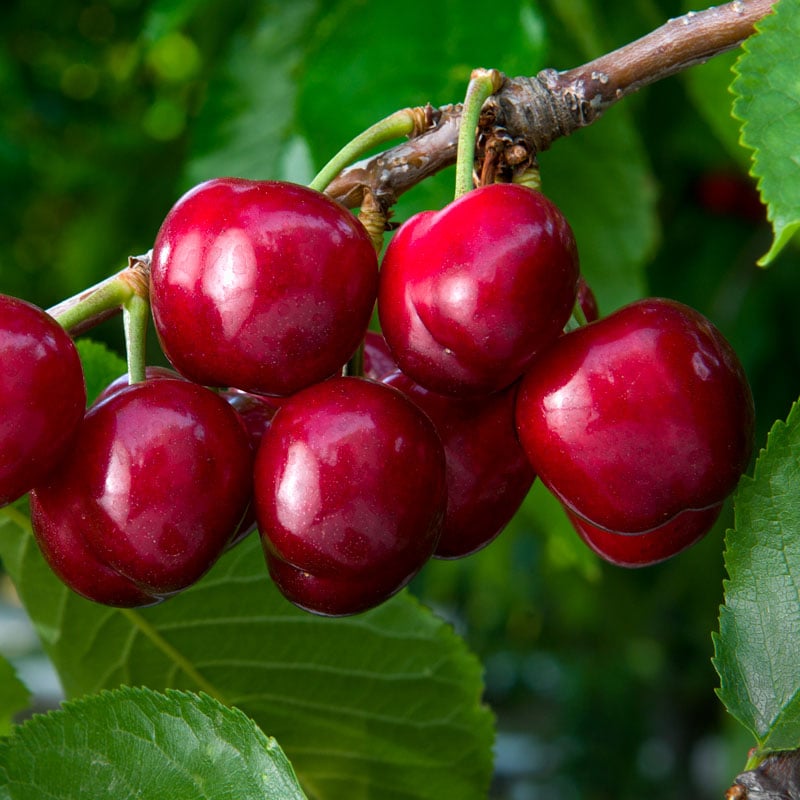
Coral Champagne fruits are attractive like their name.
There is no exact proof of the origin of Coral Champagne cherries, but in general, they belong to sweet cherry species (Prunus avium) that can bear large fruits with attractively glossy dark red skin.
The flesh itself is also sweet, firm, and low-acid in hot pink color. However, Coral Champagne is susceptible to cracking or splitting caused by rainy weather. And they are not a self-pollinated type.
In 2014, they were recorded as the third most widely planted cherry type in California (after Bing and Tulare species). Another good side of Coral Champagne cherry trees is they can be an excellent type for commercial production and home orchard due to their compact size.
Origin: Not specified (but mostly found in California)
Season: Can harvest from mid-May to mid-June
This Coral Champagne cherry farm tour will show you more interesting information about this cultivar.
19. Black Tartarian
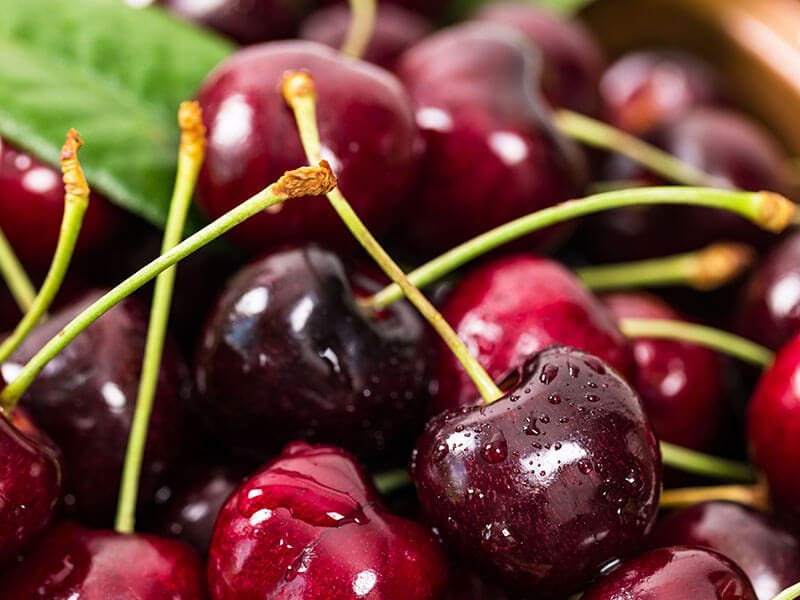
Originating in the 1700s, Black Tartarian is an old cherry cultivar in the sweet cherry group. They first appeared in Russia, then were introduced to America and England to become a popular species for home orchards.
Specifically, Black Tartarian cherry can develop well in full-sun condition and well-drained soil. They might not be a perfect drought-tolerant tree, but overall, this species can adapt to drought better than other cherry types.
And similar to other cherry species, they are not a self-pollinating type. Therefore, they should stay close to other sweet cherries like Van, Stella, or Bing to pollinate.
In optimal conditions, they can produce an abundance of juicy, robust, and sweet fruits with dark red flesh in heart-shaped forms. So if you need an easy-to-grow cherry type with fruits suitable for fresh consumption or making preserves, Tartarian is the one you are looking for.
Origin: Russia
Season: Start to ripen from mid-June to early July
20. Kordia
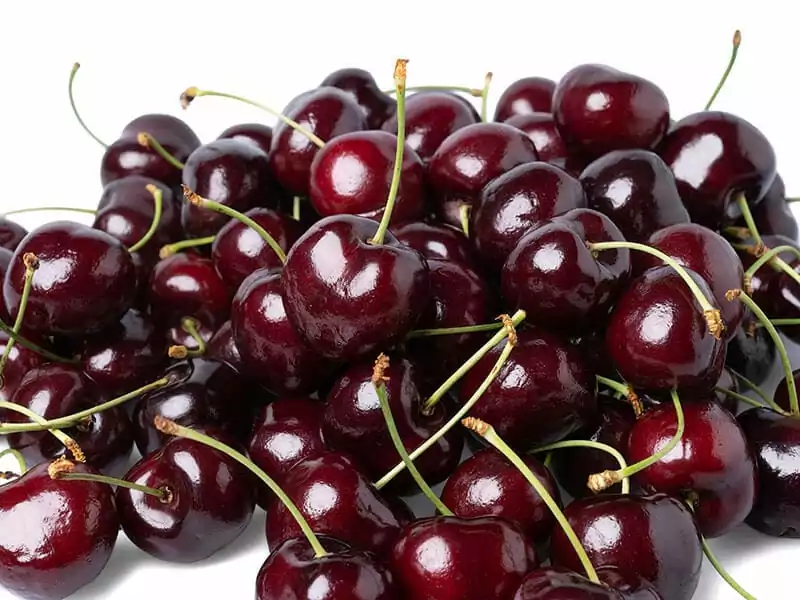
Kordia cherries boast a glossy, dark purple to black color in a heart-shaped appearance that will make you want to devour them right off the tree.
Hailing from the Czech Republic, they are a type with average productivity. However, thanks to their sweet flavor with excellent acidic undernotes, they are a well-loved choice for both commercial and home gardeners.
Besides their stunning look, Kordia cherries are also bigger than the average size. Therefore, this type can be considered a high-quality cherry variety. It is good at resisting cracking or splitting, too.
Origin: Czechoslovakia, Czech Republic (1963)
Season: Mid-late season (might be harvested in early August)
Kordia cherry in season is promising with many high-grade and big-sized fruits.
8 Types Of Sour (Or Tart) Cherries That Beyond Your Ken
Prunus cerasus is a group of sour cherries (or tart cherries). Their fruits are edible, though with a higher acidic content. Native to Southwest Asia and Europe, they are mostly used in cooked dishes, from sweet to savory recipes.
Sour cherries are very popular in Turkey, Russia, the USA, Ukraine, etc. In these countries, locals also use these fruits as a good source to make syrup and use it for creating different drinks, liquors, or beers.
Sour cherries have 2 main groups: Morello cherries and Amarelle cherries. What is the difference between these 2 big categories? And what are the cherry types in each group? Let’s check out the next section for the answer.
What Is Morello Cherry, And How Many Types Are There?
Unlike sweet cherry varieties, sour cherries (either Morello or Amerelle) are self-pollinating. But Morello cherries come with dark red flesh and offer red juice.
But do you know a glass of tart cherry juice is a good idea for summer breakfast? They can offer a lot of great health benefits. And now, let’s check these 4 popular Morello-style cherries with a lot of delightful information.
21. English Morello
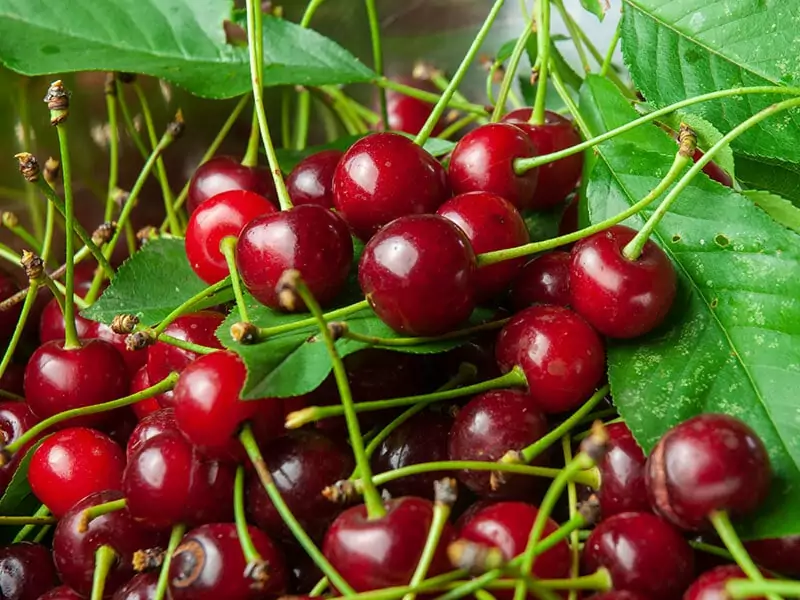
The exact root of English Morello cherries is unknown, though many people believe they are European-based cultivars. The first appearance of this type was in the mid-1800s in the United States.
As a sour cherry type, their rich sour flesh is a great component to make jams, jellies, canned foods, or other cooking ideas. You can also eat them off the tree if you like the tart taste.
They can bear abundant fruits to provide high production. These fruits have beautiful deep red (or almost black) skin with firm flesh when mature.
Origin: Unclear (but many people think their origin is England/Europe, and they were introduced to the USA in the mid-1800s)
Season: Ripen in mid-summer (around) August
Check here to learn more about growing a Morello cherry tree.
22. North Star
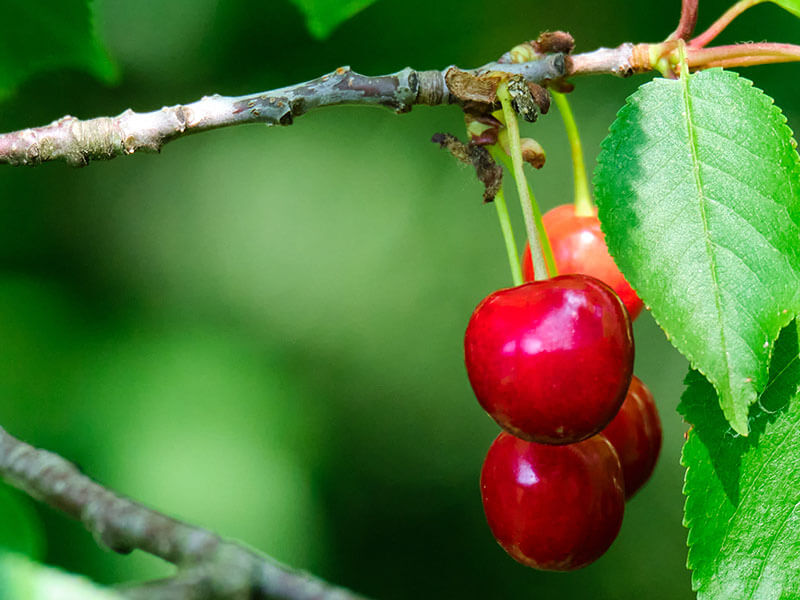
North Star cherry is a dwarf-type tree that can fit well in any kind of space, even limited ones. They can provide many light red fruits from early or mid-summer, and these fruits can hang on the tree for a long time even after they fully mature.
In 1950, the University of Minnesota (Canada) introduced this species. It soon became popular thanks to extreme climate adaptability and disease resistance to avoid cracking. They are also a self-fertile type that does not need to stand nearby any cherry tree to yield fruits.
This is a versatile cherries as you can consume them directly from the tree, make baked goods, and more, thanks to its nice sweet and sour flavor. However, some people may find it a little too much for their taste.
Origin: Canada (the University of Minnesota in 1950)
Season: Ripen around early to mid-summer
Perfect tips and tricks to have a nice-shaped North Start cherry tree are all in this instruction.
23. Balaton
As a Morello-style cherry, Balaton features a dark burgundy color in pulp and skin. But their taste is not 100% sour; you can still sense a pleasantly sweet-and-tart flavor from these fruits.
The first Balaton cherry tree was found in a small town in eastern Hungary named Ujfeherto. In 1984, Dr. Amy Iezzoni at Michigan State University introduced this species to America. By 1998, the Balaton cherry tree was commercially developed across the country.
Balaton cherries are superb for juice and pies since they are large with a firm texture. Some people think they are even superior to Montmorency – a classic pie cherry in America.
Origin: Ujfeherto, Eastern Hungary
Season: Late-season
24. Evans
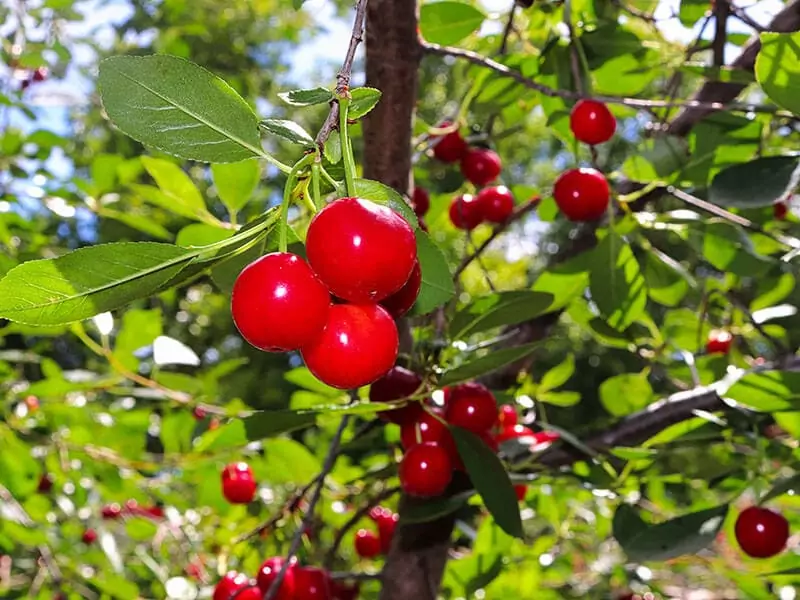
The stunning sight of Evans cherry trees covered in white, fragrant flowers from various clusters bathed under the sun in the spring will show you how beautiful they are. However, despite their elegant blossoms, this cultivar is quite hardy and can grow in harsh climates.
Some claim Evans cherry’s (aka Bali cherry) origin is from Alberta (Canada), but some research shows they might come from Alaska. Nowadays, you can find them in some regions in Canada and America.
These trees produce red, round, and fleshy fruit with a similar sour flavor to other sour cherries. They normally have compact sizes, so people grow them mainly for homemade edibles.
Origin: Alberta, Canada (around 1923 or earlier)
Season: Produce fruits in mid-summer
25. Amarena
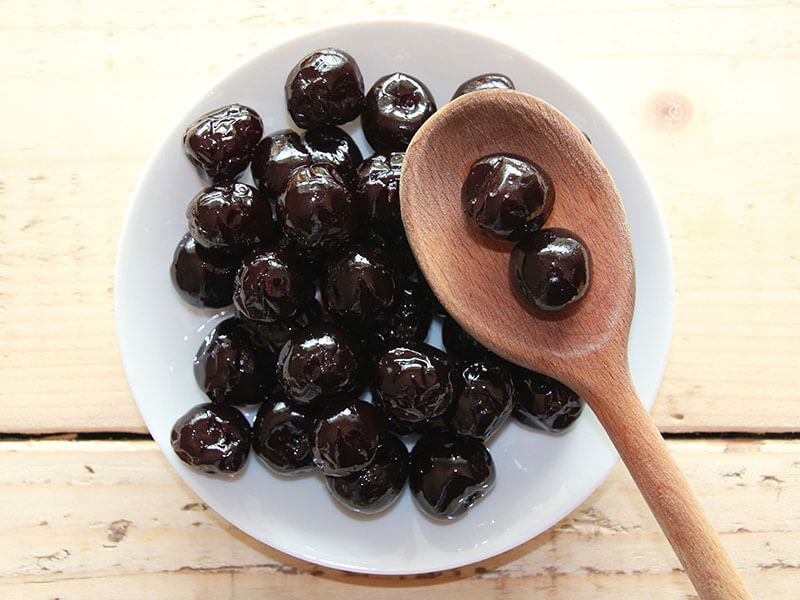
Native to Italy, Amarena cherries feature a small, dark color appearance and are usually used to decorate people’s favorite white chocolate-based desserts. Though their main flavor is tart and quite bitter, they still are a delicious fruit to enjoy with your dishes or drinks, especially cocktails.
This type of cherry is mainly grown in Modena and Bologna cities in Italy, but its popularity in other countries is huge. It is a special ingredient for ice-creams and patisserie to make them more flavorful. However, you can mostly find these cherries in bottles or jars with syrup.
Origin: Bologna, Italy (1869)
Season: Available year-round
What is Amarena cherry and how special are they? You will find the answer after checking this documentary.
Amarelle-Style Cherry And Its Varieties
Another sour cherry category is Amarelle cherry, with distinguishing traits like yellow pulp and clear juice. But their flavors are similar to other sour cherries.
26. Montmorency
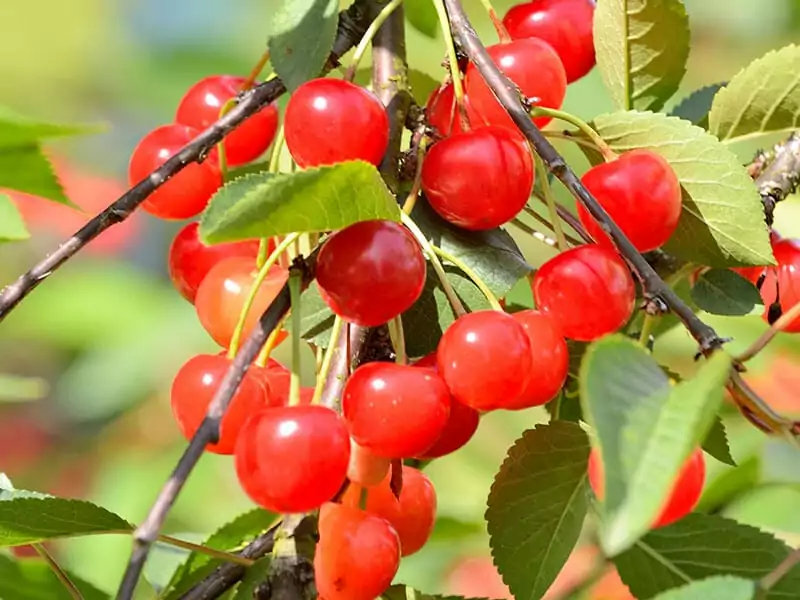
With Montmorency in France as its place of origin, Montmorency is another notable sour cherry variety globally. They are summer-harvested type, but you can find them all year round in frozen, dried foods or juices/juice concentrate.
Americans started to cultivate them in the early 20th century, and they have been the most popular ones in this country, with 1/3 production grown in Michigan (over 90,000 tons each year). But you can also find them in other places like Washington, Utah, Wisconsin, New York, and more.
Montmorency cherries have a light red color with small sizes. Have one bite, and you will sense their tartness along with some slight sweet notes. Their texture is also firm and suitable for snacks or baked goods.
Origin: Montmorency, France
Season: Harvest in summer (July to August)
Let’s visit a Montmorency orchard in Michigan and see the attractiveness of these fruits.
27. Early Richmond
Early Richmond cherries have a tart, flavorful flavor so they can be a great addition to baking dishes, for example, mouthwatering puff pastry desserts with cherries, cocktails, or preserves.
There is no proven evidence about the exact origin of Early Richmond. However, these cherry species were grown in England from the early 1500s. Later, the early settlers brought them into America, where the variety later became one of the leading sour cherries in the country,
Bright red skin, medium size, and yellowish juicy flesh are some significant features of Early Richmond cherries. Plus, their ripening time is sooner than other types by approximately 1 week and normally happens in early June.
Origin: Unclear, but was cultivated in England in the early 1500s
Season: Early summer (early June)
28. Meteor
The last tart cherry in this list is Meteor – a dwarf cherry tree that can bear many bright red fruits with large production. They can produce fruits after 2 to 3 years of planting with proper care.
Basically, Meteor cherries are large with yellowish flesh – a significant factor to classify them as belonging to the Amarelle group. Due to their tart flavor, people mainly use them for baked dishes, especially pies. Turning them into refreshing juice, jams, or jellies is also a fantastic idea.
Origin: The University of Minnesota, Canada in 1952
Season: Ripen from mid or late-season
Other Edible Cherry Types To Discover
The following two types of cherries are quite wonderful and can be used in many cooking ideas as well as raw consumption. Let’s discover what they have to offer!
29. Nanking
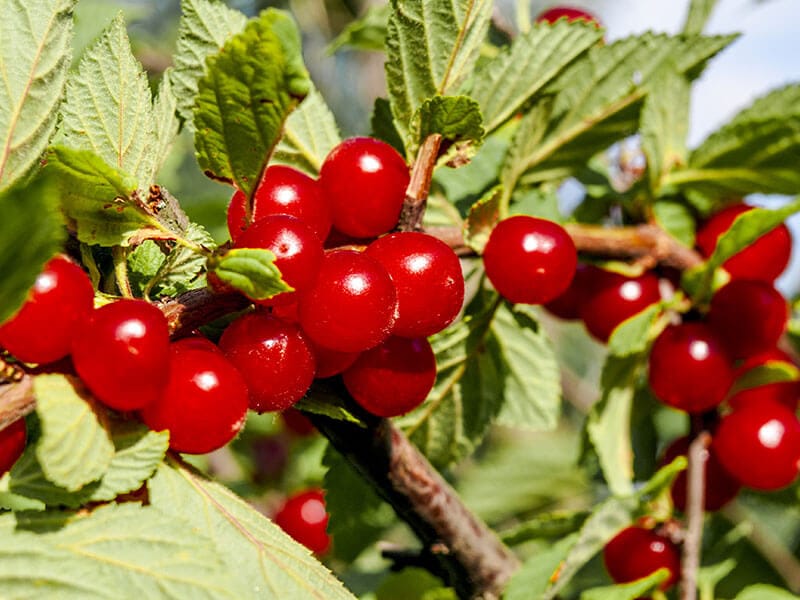
Nanking cherry is neither Prunus avium nor Prunus cerasus species. They belong to the Prunus tomentosa species originating from Mongolia, Korea, and parts of China.
This type also has various names indicating their Asian origin like Shanghai cherry, Chinese bush cherry, Korean cherry, etc. Generally, these edible cherries can be used to make jam, juice, pickled foods, wine, or you can eat them fresh.
Their flavor profile is sweet but has a slight hint of tartness. They are also ideal for home gardening purposes as their pale pink or white blossoms are very fragrant and beautiful.
Origin: Mongolia, Korea, and parts of China
Season: From July to August
A short overview of Nanking cherry will tell you more about them.
30. Maraschino
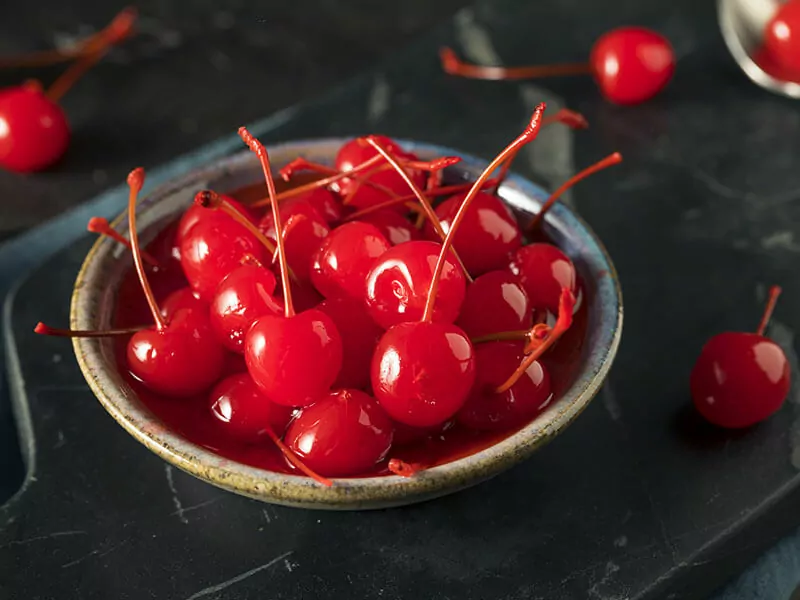
Maraschino is a famous cherry used in alcoholic (cocktails) and non-alcoholic drinks. However, it isn’t a natural type of cherry but rather a product of human ingenuity.
People make Maraschino cherries by preserving cherries of any kind in a brine solution (to bleach the color of the cherries) before soaking them in food coloring and sweetened agent (like sugar syrup).
Maraschino cherries can be made from both sour and sweet cherries. Suitable cherry varieties to make Maraschino cherries normally are light-colored cultivars, like Rainier, Royal Ann, or some Gold types.
Besides being an excellent ingredient to garnish cocktails, these beautiful cherries are ideal for decorating baked dishes, ice cream, or frozen yogurt.
You can create a big jar of Maraschino at home effortlessly with this instruction.
Health Benefits Of Consuming Cherries
Compared to other fruits, cherries are small in size, but their health benefits are massive. Let’s have a quick look at the multiple advantages of eating cherries.
A Great Source Of Nutrients
Regardless of sweet or sour cherries, they are the perfect package of vitamins, minerals, and fiber, especially vitamin C and potassium. They are vital to helping your body function smoothly.
A Treasure Trove Of Antioxidants
Looking for a fruit rich in antioxidants and anti-inflammatory compounds? Cherry is the ultimate answer. These compounds can prevent many serious illnesses like cancer, diabetes, heart disease, obesity, and Alzheimer’s.
Help You Sleep Better
Tart cherries contain melatonin – a hormone that can help your body release better before going to sleep. So if you have insomnia, try to drink around 8 ounces of tart cherry juice in the morning or 1 to 2 hours before bedtime.
Lower Gout-Related Risks
People who consume cherries have a lower gout risk than those who do not. The reason is that cherries can reduce uric acid – a waste chemical in blood that is linked with gout, kidney stones, pains, and swellings.
Can Ease Your Pain After Exercise
Interestingly, the anti-inflammatory and antioxidant compounds in these fruits can ease muscle pain after workouts or exercises, particularly if you drink tart cherry juice.
Control Bad Cholesterol
Once again, tart juice plays an important role in lowering bad cholesterol and reducing heart disease or heart attack risk.
Cherry – The Incredible Fruit On Earth
Besides the tastiness and juiciness that cherries can bring to your meals, their health benefits are unquestionable. They are also low in calories, so if you are seeking a wonderful fruit for your diet plans, count on cherries.
Also, cherry blossoms are beautiful and will make an ideal addition to your backyard. So, what do you think about cherries? What is your favorite type among these varieties? Please share your opinion of these heavenly-sent fruits in the comment section.
Also, it would mean a lot to me if you could like and share this post with your family and friends. Thank you for your support!
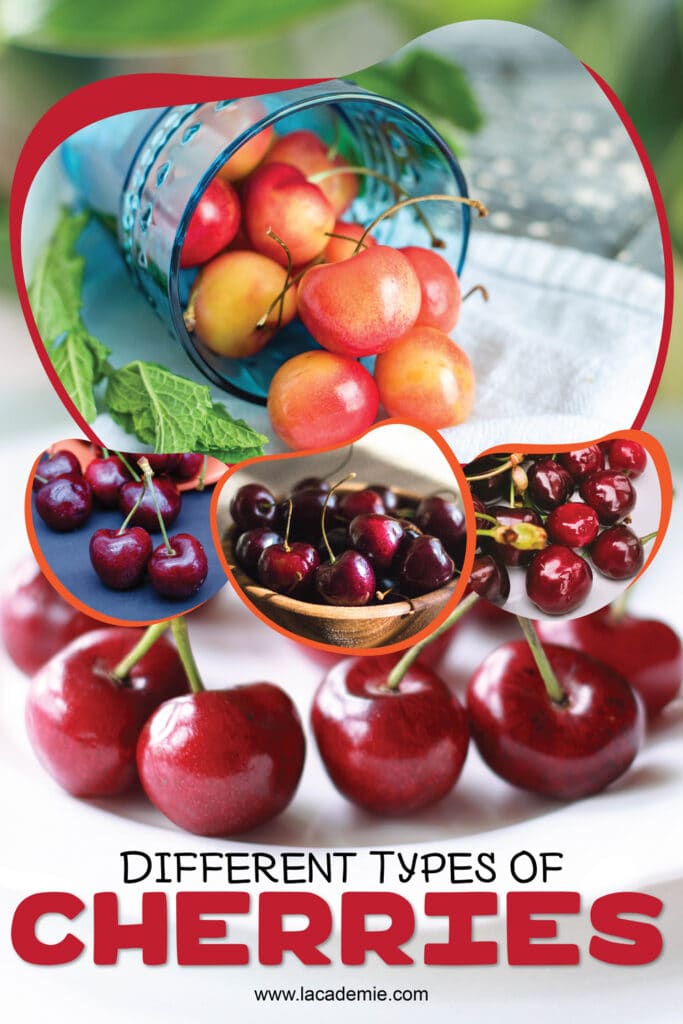


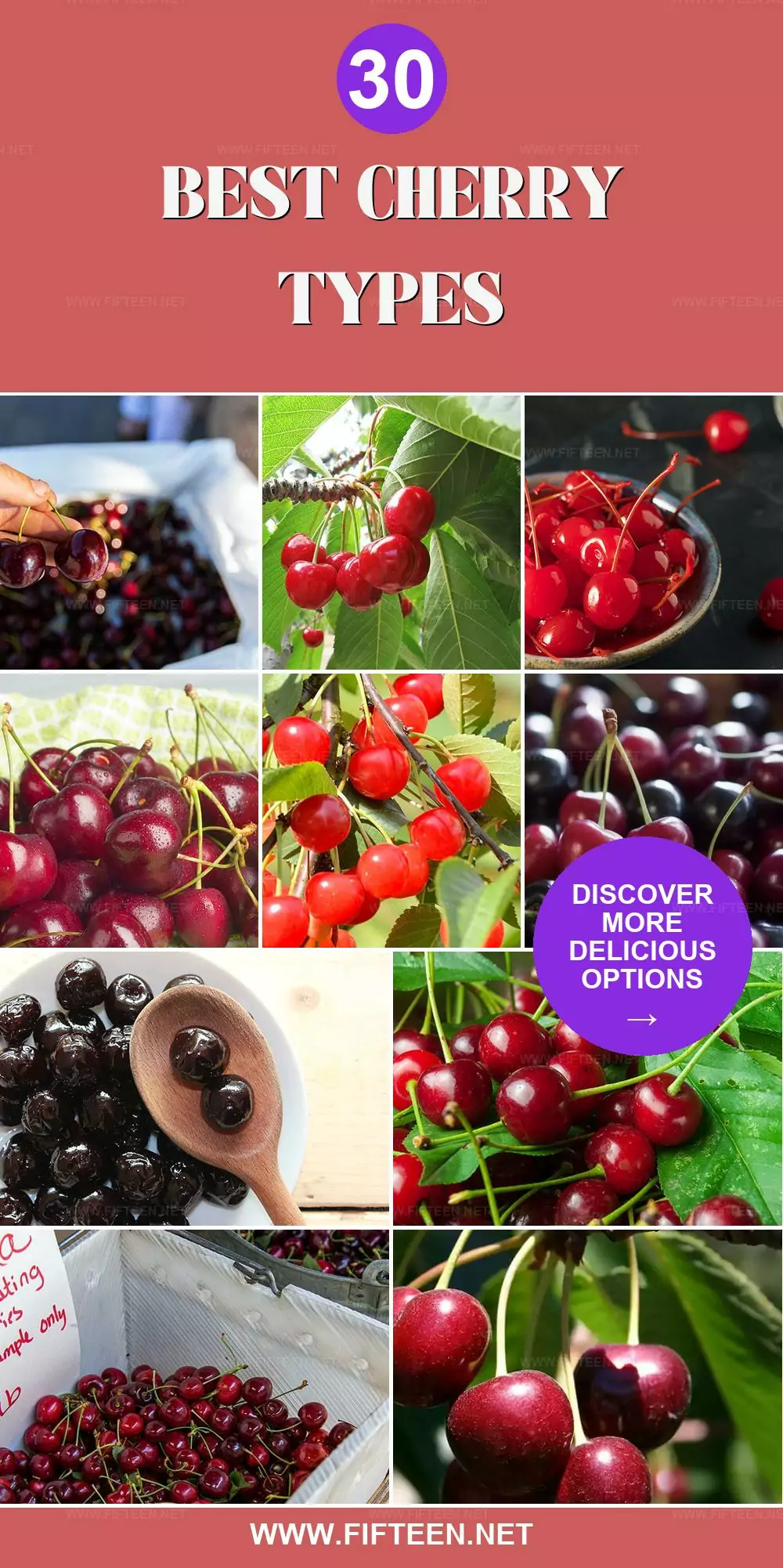
Truc Tran (Kris)
Senior Content Writer
Expertise
Home Cooking, Meal Planning, Recipe Development, Baking and Pastry, Food Editor, Cooking-video Maker, Asian Food Content Creator, Vietnamese Food Evaluation Expert
Education
TasTAFE, Australia
Kendall College (Australia Branch in Sydney)
HNAAu School (Vietnam, International Joint Training Program)
Kris, also known as Truc Tran, is a seasoned food writer and editor. She loves exploring all kinds of foods, from quick street foods to fancy restaurant dishes. In her writing, she brings together different tastes, cooking methods, and traditions of cuisines, showing how each culture’s food or drink is unique. On Fifteen.net, Kris shares her deep knowledge, especially about Asian food and traditional meals from across the globe.